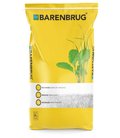| It is just over the last few decades; the use of Chicory has started to grow in North America. Chicory is a "Forb," not a Legume; it is a short-lived summer perennial. Originating from Central Europe, Chicory will survive 2-4-years on average. It is a deep-rooted plant, with the ability to grow as tall as 4-6 feet tall (if not kept grazed), with light purple flowers and broad leaves. Since Chicory is deep-rooted, it handles drought exceptionally well. It's best production months are in the early spring and into summer, although it remains productive from March to October in most regions. Many producers grow Chicory as a companion in both cool and warm-season perennial grasses although it can be grown as a stand-alone crop. |
 |
Chicory has a high forage water content, meaning, it is best used for grazing livestock, and not for harvesting for hay.
Typically a seeding rate of 3-5lbs/acre is appropriate when planting Chicory. If planting in the Southern United States, plant in September through October. If planting in the Northern United States and Canada, plant in April to May. Chicory grows best in fertile, well-drained soils
Barenbrug offers a brand of Chicory, Forb Feast. That will allow for high feed value for your animals. Forb Feast is part of our PinPoint family of products that will provide extra grazing during the "summer slump" of summer.


